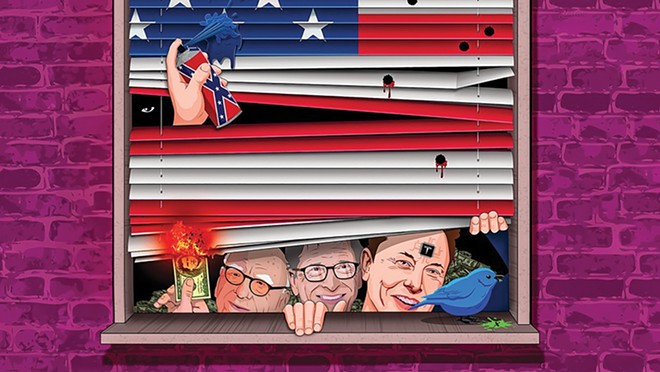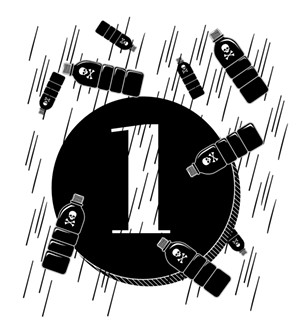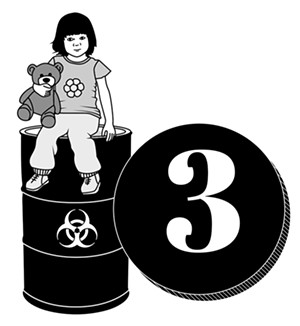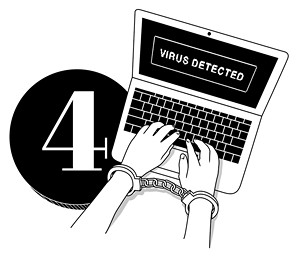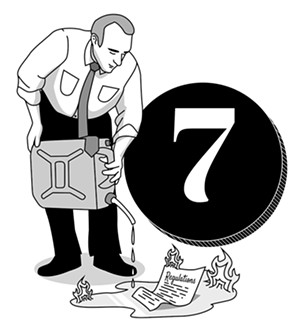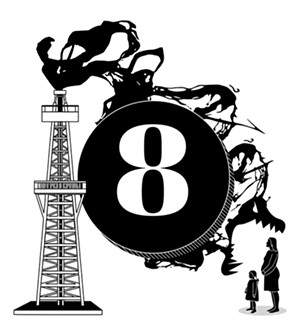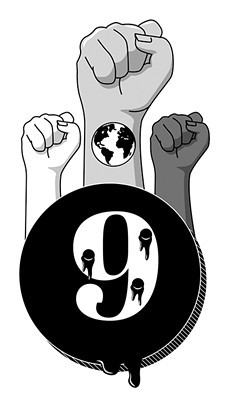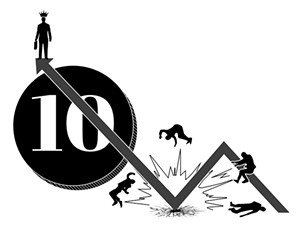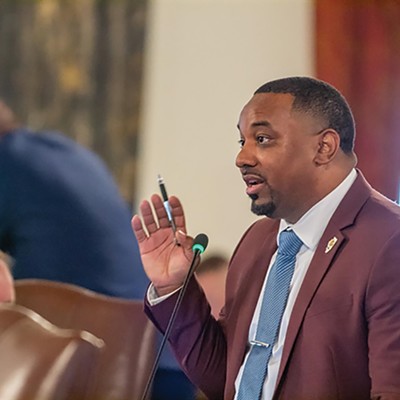"We have made the planet inhospitable to human life." That's what the lead researcher in Project Censored's No. 1 story this year said. He wasn't talking about the climate catastrophe. He was talking about so-called "forever chemicals," per- and poly-fluoroalkyl substances (PFAS), linked to prostate, kidney and testicular cancer and additional health risks, and the study he led found unsafe levels in rainwater worldwide.
Even though this story received some corporate media attention – in USA Today and the Discovery Channel – the starkly shocking bottom line clearly didn't come through to the general public. Have you heard it before? Has it been the subject of any conversation you've had? No? Well, that, my friend, is the very essence of what Project Censored's signature top 10 list is all about: Exposing the suppression (active or passive) of vitally important information from the public, which renders the public unable to act in the way that a healthy democratic public is supposed to. They've been doing it since Carl Jensen began it with a single college class in 1976, inspired in part by the way the Watergate story got this same sort of treatment until well after the election cycle it was part of.
But there's a second story intertwined with the forever chemicals' pervasive presence: the revelation that companies responsible for them have known about their dangers for decades, but kept those dangers hidden – just like fossil fuel companies and climate catastrophe. The intersection of environmental/public health and corporate criminality is typical of how certain longstanding patterns of censored news weave together across the years, even decades, and how the spotlight Project Censored shines on them helps to make sense of much more than the individual stories it highlights, as vitally important as they are in themselves.
The themes in the No. 1 story – environmental harm and corporate abuse – so dominate the top 10 story list that they send another message as well, a message about the fundamental mismatch between our needs as a species living on a finite planet and a rapacious economic system conceived in ignorance of that fact. The climate catastrophe is just the most extreme symptom of this mismatch, but it's far from the only one. Corporate abuse figures into every story in the list – though sometimes deep in the background, as with their decades-long efforts to destroy unions in story No. 6. Environmental harms 'only' show up in seven of the 10 stories.
There are still other patterns here, to be sure, and I encourage you to look for them yourself because seeing those patterns enriches your understanding of the world as it is, and as it's being hidden from you. But this dominant pattern touches us all. The evidence is right there, in the stories themselves.
1. "Forever chemicals" in rainwater a global threat
Rainwater is "no longer safe to drink anywhere on Earth," Morgan McFall-Johnsen reported in Insider in August 2022, summing up the results of a global study of so-called "forever chemicals," or polyfluoroalkyl substances (PFAS), published in the journal Environmental Science & Technology. Researchers from Stockholm University and the Institute of Biogeochemistry and Pollutant Dynamics at ETH Zurich concluded that "in many areas inhabited by humans," PFAS contamination levels in rainwater, surface water and soil "often greatly exceed" the strictest international guidelines for acceptable levels of perfluoroalkyl acids.
They're called "forever chemicals" because they take so long to break down, "allowing them to build up in people, animals, and environments," Insider reported. Project Censored notes, "Prior research has linked these chemicals to prostate, kidney and testicular cancer and additional health risks, including developmental delays in children, decreased fertility in women and men, reduced vaccine efficacy and high cholesterol."
2. Blurred lines between big tech and big brother
"Google – one of the largest and most influential organizations in the modern world – is filled with ex-CIA agents," Alan MacLeod reported for MintPress News in July 2022. "An inordinate number of these recruits work in highly politically sensitive fields, wielding considerable control over how its products work and what the world sees on its screens and in its search results."
And more broadly, "a former CIA employee is working in almost every department at Google," Project Censored noted.
But Google isn't alone. Nor is the CIA. "Former employees of U.S. and Israeli intelligence agencies now hold senior positions at Google, Meta, Microsoft and other tech giants," Project Censored wrote. A second report focused on employees from Israel's Unit 8200, its equivalent of the CIA, which is "infamous for surveilling the indigenous Palestinian population," MacLeod wrote. Using LinkedIn, he identified hundreds of such individuals from both agencies, providing specific information about dozens of them.
"The problem with former CIA agents becoming the arbiters of what is true and what is false and what should be promoted and what should be deleted is that they cut their teeth at a notorious organization whose job it was to inject lies and false information into the public discourse to further the goals of the national security state," MacLeod wrote, citing the 1983 testimony of former CIA task force head John Stockwell, author of In Search of Enemies, in which he described the dissemination of propaganda as a "major function" of the agency.
Reinforcing that concern is big tech's history. "As journalist Nafeez Ahmed's investigation found, the CIA and the NSA were bankrolling Stanford Ph.D. student Sergey Brin's research – work that would later produce Google," MacLeod wrote. "Not only that but, in Ahmed's words, 'senior U.S. intelligence representatives, including a CIA official, oversaw the evolution of Google in this pre-launch phase, all the way until the company was ready to be officially founded.'"
This fits neatly within the larger framework of Silicon Valley's origin as a supplier of defense department technology.
3. Toxic chemicals continue to go unregulated
The United States is "a global laggard in chemical regulation," ProPublica reported in December 2022, a result of chemical industry influence and acquiescence by the Environmental Protection Agency over a period of decades, according to reporters Neil Bedi, Sharon Lerner and Kathleen McGrory. A headline example: asbestos, one of the most widely-recognized toxic substances, is still legal in the U.S., more than 30 years after the EPA tried to have it banned.
"Through interviews with environmental experts and analysis of a half-century's worth of legislation, lawsuits, EPA documents, oral histories, chemical databases and regulatory records, ProPublica uncovered the longstanding institutional failure to protect Americans from toxic chemicals," Project Censored reported. ProPublica identified five main reasons for failure:
• The chemical industry helped write the 1976 Toxic Substances Control Act. The law "allowed more than 60,000 chemicals to stay on the market without a review of their health risks" and required the EPA to always choose the "least burdensome" regulations. "These two words would doom American chemical regulation for decades," ProPublica reported.
• The EPA lost its resolve. In 1989, after 10 years of work, the EPA was banning asbestos. But companies that used asbestos sued and won in 1991, based on a court ruling that they'd failed to prove it was the "least burdensome" option. However, "the judge did provide a road map for future bans, which would require the agency to do an analysis of other regulatory options ... to prove they wouldn't be adequate," but rather than follow through, the EPA simply gave up.
• Chemicals are considered innocent until proven guilty. For decades, the U.S. and EU used a "risk-based" approach to regulation, requiring the government to prove a chemical poses unreasonable health risks before restricting it, which can take years. In 2007, the EU switched to a "hazard-based" approach, putting the burden on companies when there's evidence of significant harm. As a result, ProPublica explained, "the EU has successfully banned or restricted more than 1,000 chemicals." A similar approach was proposed in the U.S. in 2005 by New Jersey Sen. Frank Lantenberg, but it was soundly defeated.
• The EPA mostly regulates chemicals one by one. In 2016, a new law amended the TSCA to cut the "least burdensome" language, and created a schedule "where a small list of high-priority chemicals would be reviewed every few years. The first 10 were selected, including asbestos," ProPublica reported. "The EPA would then have about three years to assess the chemicals and another two years to finalize regulations on them." But six years later, "the agency is behind on all such rules. So far, it has only proposed one ban, on asbestos, and the agency told ProPublica it would still be almost a year before that is finalized." Industry fights the process at every step.
• The EPA employs industry-friendly scientists as regulators. "The EPA has a long history of hiring scientists and top officials from the companies they are supposed to regulate, allowing industry to sway the agency's science from the inside," ProPublica wrote. A prime example is Todd Stedeford. "A lawyer and toxicologist, Stedeford has been hired by the EPA on three separate occasions," ProPublica noted. "During his two most recent periods of employment at the agency – from 2011 to 2017 and from 2019 to 2021 – he was hired by corporate employers who use or manufacture chemicals the EPA regulates."
4. Stalkerware could be used to incriminate people violating abortion bans
Stalkerware – consisting of up to 200 surveillance apps and services that provide secret access to people's phones for a monthly fee – "could become a significant legal threat to people seeking abortions, according to a pair of articles published in the wake of the U.S. Supreme Court's decision to overturn the constitutional right to abortion," Project Censored reports.
"Abortion medication is safe. But now that Roe is overturned, your data isn't," Rae Hodge wrote for the tech news site CNET just two days after the Dobbs decision. "Already, the digital trails of abortion seekers can become criminal evidence against them in some states where abortion[s] were previously prosecuted. And the legal dangers may extend to abortion seekers in even more states."
The next month, writing for Slate, University of Virginia law professor Danielle Keats Citron warned that "surveillance accomplished by individual privacy invaders will be a gold mine for prosecutors targeting both medical workers and pregnant people seeking abortions."
It's not just abortion, she explained, "Your phone's data, your social media accounts, your browsing and geolocation history, and your ISP's detailed records of your internet activity may all be used as evidence if you face state criminal or civil charges for a miscarriage."
And "abortion bounty hunter" provisions adopted by states like Texas and Oklahoma, add a financial incentive. "Given the inexpensive cost of readily available stores of personal data and how easily they can be de-anonymized, savvy informants could use the information to identify abortion seekers and turn a profit," she noted.
"The law's response to intimate privacy violations is inadequate, lacking a clear conception of what intimate privacy is, why its violation is wrongful and how it inflicts serious harm upon individuals, groups, and society," Citron explained. "Until federal regulations and legislation establish a set of digital privacy laws, abortion-seekers are caught in the position of having to create their own patchwork of digital defenses, from often complicated and expensive privacy tools," Hodge warned. While the bipartisan American Data Privacy and Protection Act is still "slowly inching through Congress" it "is widely thought toothless," she wrote.
5. Certified rainforest carbon offsets mostly "worthless"
"The forest carbon offsets approved by the world's leading certifier and used by Disney, Shell, Gucci and other big corporations are largely worthless and could make global heating worse, according to a new investigation," the Guardian reported on Jan. 23, as part of a joint nine-month reporting project with SourceMaterial, and Die Zeit.
"About 90% of rainforest carbon offsets certified by Verra, the world's largest offset certifier, do not reflect real reductions in emissions," Project Censored summed up.
Specifically, "The investigation of 29 Verra rainforest offset projects found that 21 had no climate benefit, seven had significantly less climate benefit than claimed (by margins of 52% to 98% less), while one project yielded 80% more climate benefit than claimed. Overall, the study concluded that 94% of the credits approved by these projects were 'worthless' and never should have been approved."
"Rainforest protection credits are the most common type on the market at the moment. And it's exploding, so these findings really matter," said Barbara Haya, director of the Berkeley Carbon Trading Project, who's researched carbon credits for 20 years. "But these problems are not just limited to this credit type. These problems exist with nearly every kind of credit," she told the Guardian. "We need an alternative process. The offset market is broken."
6. Unions won more than 70% of their elections in 2022
Unions won more than 70% of their certification elections in 2022, according to reporting by NPR and The Conversation, and workers of color were responsible for 100% of union growth, according to an analysis by the Economic Policy Institute reported by Payday Report and the New Republic.
The National Labor Relations Board reported 2,510 petitions for union representation filed in fiscal year 2022, up 53% from F 2021. Seventy-two percent of the 1,249 certification elections were held voted to certify a union as their collective bargaining agent. "The entire increase in unionization in 2022 was among workers of color – workers of color saw an increase of 231,000, while white workers saw a decrease of 31,000," EPI wrote in a February 2023 press release.
EPI also noted that "Survey data show that nearly half of nonunion workers (48%) would vote to unionize their workplace if they could. That means that more than 60 million workers wanted to join a union, but couldn't. The Protecting the Right to Organize Act and the Public Service Freedom to Negotiate Act provide crucial reforms that would strengthen workers' rights to form a union and engage in collective bargaining." It passed the House in 2020 and 2021 but died in the Senate, where it needed 60 votes to pass because of the filibuster.
"Corporate media coverage of the labor resurgence of 2022 was highly selective and, in some ways, misleading," Project Censored reported. There've been hundreds of articles on union organizing at Starbucks and Amazon and among graduate students, "Yet corporate coverage of current labor organizing often fails to address the outsized role played by workers of color in union growth." Nor has it placed recent union successes in the historical context of prolonged decline, largely due to private employers' heavy-handed efforts to undermine organizing campaigns and labor laws that strongly favor employers.
7. Fossil fuel investors sue governments to block climate regulations
"Litigation terrorism" is what Nobel Prize-winning economist Joseph Stiglitz called the practice of fossil fuel companies and investors suing governments in secretive private tribunals to thwart climate change policies. Litigants claim climate change laws undermine their profits, and thus they must be compensated under what's known as "investor-state dispute settlement" legal actions, Rishika Pardikar reported for The Lever in June 2022, following a paper in Science by lead author Kyla Tienhaara the month before. It found that "Global action on climate change could generate upward of $340 billion in legal claims from oil and gas investors," which, "is more than the total level of public climate finance globally in 2020 ($321 billion)."
A good portion threatens the Global South. "The five countries with the greatest potential losses from ISDS are Mozambique ($7-31 billion), Guyana ($5-21 billion), Venezuela ($3-21 billion), Russia ($2-16 billion) and the United Kingdom ($3-14 billion)," Tienhaara reported. What's more, "If countries decide to also cancel oil and gas projects that are currently under development, this could introduce substantial additional financial losses from ISDS claims."
"Such [litigation] moves could have a chilling effect on countries' ability to take climate action because of the fear and uncertainty they cause," Pardikar noted. "New Zealand, for example, recently said that it could not join the Beyond Oil and Gas Alliance, an international consortium of governments working to phase out fossil fuels, because doing so 'would have run afoul of investor-state settlements,'" Lois Parshley reported for Grist in January 2023.
Project Censored also cited Lea Di Salvatore's December 2021 report that fossil fuel "investors succeeded in 72% of all cases," winning an average over $600 million, "almost five times the amount awarded in non-fossil fuel cases." In addition, secrecy is the rule. "54% of the concluded fossil fuel cases are confidential – while their existence is known, no case-related documents, such as awards or decisions, have been made public."
8. Proximity to oil and gas extraction sites linked to health risks
"Two epidemiological studies, from 2021 and 2022, provide new evidence that living near oil and gas extraction sites is hazardous to human health," Project Censored reports, "especially for pregnant mothers and children, as reported by Nick Cunningham for DeSmog and Tom Perkins for the Guardian."
Based on 1996-2009 data for more than 2.8 million pregnant women in Texas, researchers from Oregon State University found that "for those pregnant women within one kilometer of drilling there's about a 5% increase in odds of gestational hypertension and 26% increase in odds of eclampsia," researcher Mary Willis told DeSmog. "So, it's this really close range where we are seeing a potential impact right on women's health." Eclampsia is a rare but serious condition where high blood pressure results in seizures during pregnancy.
"Notably, the data in the OSU study predate the widespread development of 'fracking,' or hydraulic fracturing, the process of extracting gas and oil from shale beds by injecting fluids at high pressure," Project Censored pointed out. The second study, from Yale, did study fracking. It found that "Young children living near fracking wells at birth (approximately 1.2 miles) are up to three times more likely to later develop leukemia," according to an August 2022 Guardian story. The study, based on 2009-2017 data from Pennsylvania, compared 405 children aged 2-7 diagnosed with acute lymphoblastic leukemia with an additional 2,080 children, matched on birth year, who didn't have leukemia.
The findings aligned with others, as DeSmog discussed. "One consistent takeaway from so many health studies related to fracking is that proximity is key," they reported. "The allowable setback in Pennsylvania, where our study was conducted, is 500 feet," Yale researcher Cassandra Clark told them. "Our findings ... in conjunction with evidence from numerous other studies, suggest that existing setback distances are insufficiently protective of children's health."
State and local governments have tried to create health buffer zones, but "The oil industry has consistently fought hard to block setback distance requirements," DeSmog reported. For example, "In 2018, the oil industry spent upwards of $40 million to defeat a Colorado ballot measure that would have imposed 2,500-foot setback requirements for drillers." Regulations are so weak that "In Texas, drilling sites can be as close as 45 meters from residences," Willis told them.
9. Deadly decade for environmental activists
At least 1,733 environmental activists were murdered between 2012 and 2021 – nearly one every two days across 10 years – according to the Global Witness study, Decade of Defiance. They were "killed by hitmen, organized crime groups and their own governments," Patrick Greenfield reported for the Guardian, "with Brazil, Colombia, the Philippines, Mexico and Honduras the deadliest countries." Half the attacks took place in the first three countries, each reporting around 300 killings.
"The killing of environmental activists has been concentrated in the Global South," and "Indigenous land defenders are disproportionately impacted," Project Censored warned. "The Guardian reported that 39% of those killed were from Indigenous communities, despite that group constituting only 5% of the global population."
"This is about land inequality, in that defenders are fighting for their land, and in this increasing race to get more land to acquire and exploit resources, the victims are indigenous communities, local communities, whose voices are being suppressed," the BBC summed up.
But, "campaigners are hopeful that progress is being made," the BBC reported, citing the sentencing of a former energy executive to 22 years in prison in Honduras for the murder of world-renowned activist Berta Cáceres in 2016, as well as promising international agreements. The Escazú agreement, the first environmental and human rights treaty for Latin America and the Caribbean "commits countries to prevent and investigate attacks on environmental defenders," and went into force in 2021. Mexico has ratified it, but "others including Brazil and Colombia have not" so far, the BBC said. There are also plans by the European Union to pass laws making companies responsible for human rights abuses in their supply chains.
"These are game-changing decisions that could make a real positive impact for environmental defenders," Shruti Suresh told the BBC. "We should be optimistic. But it is going to be a difficult and challenging road ahead."
10. Corporate profits hit record high
"Corporate profits in the U.S. surged to an all-time record of $2 trillion in the second quarter of 2022 as companies continued jacking up prices, pushing inflation to a 40-year high to the detriment of workers and consumers," Jake Johnson reported for Common Dreams in August 2022. "Astronomical corporate profits confirm what corporate executives have been telling us on earnings calls over and over again: They're making a lot of money by charging people more, and they don't plan on bringing prices down anytime soon," the Groundwork Collaborative's chief economist, Rakeen Mabud, said.
This followed Johnson's reporting in March that the average bonus for Wall Street employees rose an astounding 1,743% between 1985 and 2021, according to an analysis by Inequality.org of New York State Comptroller data. Then, in December 2022, he reported that "earnings inequality in the United States has risen dramatically over the past four decades and continues to accelerate, with the top 0.1% seeing wage growth of 465% between 1979 and 2021 while the bottom 90% experienced just 29% growth during that same period," according to research by the Economic Policy Institute. As a result, the average incomes of the top 0.1% rose from 20 times that of the bottom 90% in 1979 to more than 90 times as much in 2021.
Paul Rosenberg is a Los Angeles, California-based writer, senior editor for Random Lengths News, and a columnist for Salon and Al Jazeera English. This article is copyrighted by Random Lengths News, a division of Beacon Light Press, 2023.

